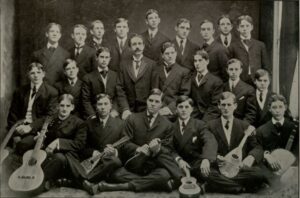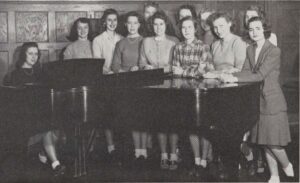
The Mandolin Club in 1905
On a college campus, the word “club” typically denotes a group of students engaged in a common interest outside the formal curriculum. The earliest music ensembles at the University of Richmond were actually clubs organized by male students. The Men’s Glee Club and the Mandolin Club date almost to the founding of Richmond College. Both groups frequently toured area colleges and appeared at social events on campus. The Glee Club performed concerts of popular selections and college songs, as well as minstrel shows in blackface. The Mandolin Club, which lasted until the early 1920s, included players of mandolins, guitars, and banjos. In some years it morphed into an “orchestra” with a motley instrumentation, depending on who showed up to play.
Across the lake, Westhampton students took the initiative to coordinate their own musical activities. Female students also had a Glee Club, formed in the early 1920s, which performed both formal concerts and staged events, including blackface minstrel shows. In addition, as early as 1915, members of the Westhampton College Music Club gathered to discuss and perform selections from well-known operas. They also organized music-themed dinners, phonograph “concerts,” and other social events. The club’s activities soon resembled a music curriculum in miniature, with programs on the history of music, the works of women composers, and the music of various nationalities. Both students and guest artists performed regularly in the Blue Room of Westhampton College (the current North Court).

The all-female Ionian Music Club in 1945
In 1938, the Westhampton College Music Club changed its name to “The Ionian Music Club,” with meetings held in the Margaret James Room of the Women’s Activity Building (today’s Keller Hall). Sometime in the late 1940s, it began admitting male students, and a few years later rebranded itself as the “University Music Club.” Its goals remained largely the same, offering performance opportunities for music students, as well as programming to help both majors and non-majors increase their musical knowledge “without the regimen of classes,” in the words of its onetime president Phil Jackson. The Music Club met in various locations both on- and off-campus, and held an annual picnic in Byrd Park. Members were service-minded, ushering at concerts, selling tickets for Richmond Symphony performances, and volunteering to play the organ for chapel services at a local hospital. In the 1960s the Music Club advocated for a dedicated fine arts building, writing letters to The Collegian about inadequate practice rooms and listening facilities in Keller Hall. The last Music Club meeting described in The Collegian took place on February 19, 1963. Gathering at Boatwright Library, club members observed a performance on the University’s carillon by music faculty member Hilton Rufty.
Many other musical organizations on campus are considered clubs, such as the a cappella groups and various other student-led ensembles that don’t grant academic credit.